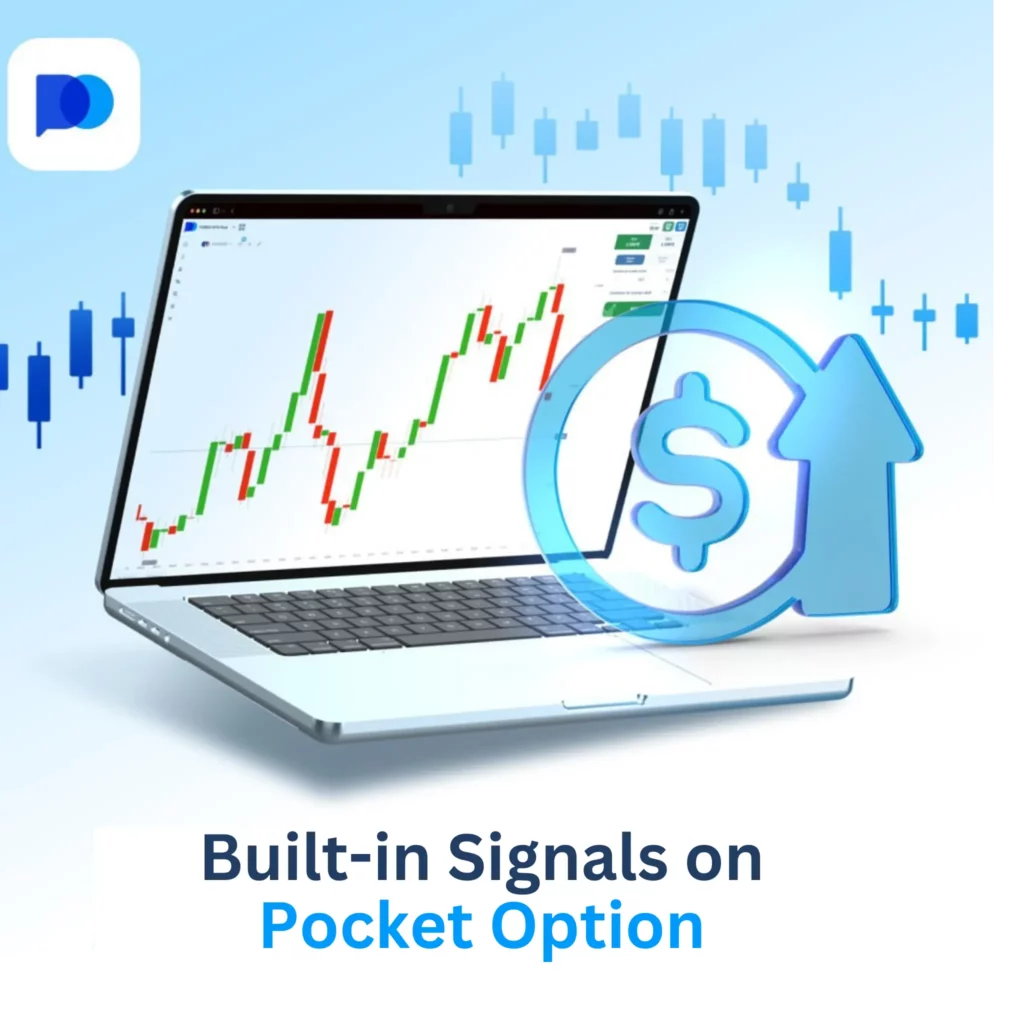Pocket Option Signals – How to Use Signals for Smarter Trading
Trading signals on Pocket Option are a helpful tool for making faster, more confident decisions in the market. These signals provide insights into when to open or close a trade based on market trends, price movements, and technical indicators. Instead of analyzing charts manually, traders can rely on signals to guide their entry or exit points—saving time and reducing uncertainty. Pocket Option offers both built-in signal features and options to connect with external services.
Signals Content Overview
What Are Trading Signals on Pocket Option?
Trading signals are real-time alerts that suggest a possible trading opportunity. They indicate when to buy or sell a particular asset, based on analysis of market data. On Pocket Option, these signals are generated through automated algorithms or shared manually by experienced traders and third-party services.
Signals are especially useful for traders who want guidance without spending hours studying technical charts. Each signal typically includes the asset name, trade direction (CALL or PUT), and sometimes the recommended expiry time. While not always perfect, signals can increase efficiency and reduce guesswork—especially when used alongside your own analysis.
Automatic vs. Manual Signals
On Pocket Option, automatic signals are generated by built-in indicators like RSI, MACD, or Bollinger Bands. These are based on real-time market conditions and appear directly on the trading platform. Manual signals, on the other hand, come from professional analysts or bots in Telegram groups and external platforms.
Automatic signals are fast and consistent, while manual signals may include deeper analysis or insight into upcoming news events. Many traders combine both to get a broader view.
How Signals Predict Market Movements
Signals rely on patterns from technical analysis—like price action, trend reversals, breakouts, and momentum indicators. For example, if RSI shows that an asset is overbought, a signal might suggest a PUT option. If MACD crosses over in an upward direction, you may get a CALL signal.
These signals work by identifying repeating market behaviors, often using historical price data to forecast future movements. While they don’t guarantee success, they offer a strong foundation for decision-making.
Can Beginners Use Signals Effectively?
Yes, beginners can benefit from using signals, especially when starting out. Signals provide a simple way to understand trading opportunities without deep technical knowledge. However, it’s important not to rely on them blindly.
For best results, beginners should:
- Use the demo account to test signal strategies.
- Combine signals with simple chart reading.
- Stick to a risk management plan.
- Avoid entering every signal—focus on quality.
Over time, learning how signals are generated helps new traders build their own judgment and trade more confidently.
Where to Get Pocket Option Signals?
There are several reliable ways to receive trading signals when using Pocket Option. These signals come from both the platform itself and external sources, offering flexibility for all types of traders. Whether you’re using built-in features or joining a Telegram bot, each option has its own strengths.

Built-In Signals on the Platform
Pocket Option includes integrated signals generated by technical indicators such as Moving Averages, RSI, Bollinger Bands, and MACD. These signals appear directly on the chart or as small alerts in the trading interface. They are based on real-time data and help users spot opportunities without leaving the platform.
To activate built-in signals:
- Log in to your Pocket Option account.
- Open the trading chart.
- Select an indicator under the “Indicators” menu.
- Watch for visual cues or pop-up alerts suggesting a CALL or PUT trade.
Built-in signals are ideal for traders who prefer a simple, centralized approach.
Signal Bots (Including Telegram Bots)
Signal bots offer real-time alerts outside the trading platform, often through Telegram channels or Chrome extensions. These bots analyze market data continuously and send trade suggestions, usually including the asset, direction (CALL/PUT), and expiry time.
Popular Telegram signal bots provide:
- Timely updates with screenshots and reasoning.
- Alerts for binary options, Forex, or crypto pairs.
- Group discussions or feedback from other users.
Some Chrome browser extensions are also designed to work directly with Pocket Option, integrating signal alerts into your desktop experience.


Third-Party Signal Services
Many traders use external sources to expand their signal options. These include:
- TradingView: You can follow chart analysts or set up alert scripts based on custom strategies.
- Copy-trading communities: Groups on Discord or social platforms where experienced traders share signals.
- Social trading on Pocket Option: Allows you to copy trades from top performers in real time, effectively using their trades as live signals.
Third-party signals are useful if you want to compare multiple sources and build a more complete market picture.
Are Pocket Option Signals Accurate?
Trading signals are powerful tools, but they are not foolproof. Accuracy can vary depending on the strategy behind the signal, current market conditions, and how the trader uses the information. To get the best results, it’s important to treat signals as guidance, not guaranteed outcomes.
No Signal Is 100% Accurate – Here’s Why
Even the most advanced algorithms and expert traders cannot predict the market with complete accuracy. Signals are based on historical data and technical patterns, which may not always play out as expected due to sudden news events, low liquidity, or unexpected price reactions.
Using any signal involves a level of risk, so it’s important to remain cautious and avoid overtrading.
Importance of Market Conditions and Timing
Signals tend to perform better in trending markets than during flat or sideways movement. For example, a breakout strategy may fail if the market lacks volume. Timing also matters—signals near major economic announcements can become unreliable due to high volatility.
Before acting on a signal, consider:
- What market session you’re in (London, New York, etc.).
- Whether the market is reacting to news.
- Timeframe compatibility with the signal’s intent.
Using Signals as Confirmation, Not Blind Entry
The best way to use signals is as part of a broader trading plan. Confirm a signal by:
- Checking if it aligns with trend direction on the chart.
- Looking for support/resistance levels.
- Reviewing candlestick patterns that match the signal.
By using signals to support your own analysis, you reduce risk and increase your chances of success.
Best Signals for Pocket Option – What to Look For
Not all trading signals are created equal. To increase your chances of success on Pocket Option, it’s essential to identify high-quality signals that are backed by logic, data, and experience. Here’s what to look for when evaluating signal quality:
A strong signal should include all key trade parameters:
- Entry Point: The exact price or market condition to initiate the trade.
- Direction: Whether to place a CALL or PUT option.
- Expiry Time: How long the trade should remain open.
Without these three elements, a signal is incomplete and can lead to misjudged entries or mistimed exits.
Before acting on a signal, make sure:
- It matches your trading timeframe.
- The entry conditions are still valid when you see the signal.
- The expiry fits within the expected movement window.
Good signals come from sources that are transparent. If you’re using a bot, Telegram group, or paid service, check if they:
- Provide past performance records or screenshots.
- Log win/loss ratios consistently.
- Are open about their strategy or analysis method.
Avoid signal providers who hide results or cherry-pick their wins.
User reviews are valuable. Look for feedback from real traders who’ve used the signals:
- On Telegram, check for pinned testimonials or chat engagement.
- On Reddit, explore discussions in trading communities like r/binaryoptions.
- On Trustpilot, read reviews about both free and paid services.
Signals with active, supportive communities are usually more reliable.
How to Use Signals in Your Pocket Option Trading
Signals are tools, not magic solutions. For best results, integrate them into a structured trading process. Here’s a practical guide to make the most of signals on Pocket Option:
Matching Signal with Chart Analysis
Before placing a trade based on a signal, always double-check the chart. Use:
- Trendlines to see if the signal follows the current trend.
- Candlestick patterns to confirm momentum or reversals.
- Indicators (like RSI or MACD) to validate the signal’s logic.
This reduces the chance of acting on weak or misaligned signals.
Choosing Expiry Time That Fits the Signal
Every signal has an intended lifespan. Don’t just guess the expiry—match it to:
- The timeframe the signal was based on (e.g., 5-min, 15-min).
- Market volatility (more movement = longer expiry may be better).
- Confirmation from your chart analysis.
If unsure, test different expiry lengths in demo mode to see what works best.
Risk Management with Signal-Based Trading
Even high-probability signals can fail. Apply proper risk control by:
- Risking only 1–5% of your balance per trade.
- Setting daily loss limits to avoid emotional trading.
- Tracking your results to see which signals or sources perform best.
Using signals with smart money management helps you stay consistent and avoid large drawdowns.
Free vs. Paid Signals – What’s Better?
Choosing between free and paid signals depends on your experience level, trading goals, and budget. Both have advantages, but also risks. Here’s how they compare:
Free signal sources—such as Telegram channels, social media, or forums—are ideal for beginners exploring different trading styles. They help you:
- Understand how signals are structured.
- Practice reading entry/exit points.
- Test strategies without financial commitment.
However, quality can vary greatly. Many free signals aren’t verified or may be delayed. Always test them in demo mode first.
Paid signals usually come with perks such as:
- Real-time delivery (Telegram bots, mobile alerts, etc.).
- Verified performance stats or backtesting data.
- Dedicated support or community access.
They can be helpful for serious traders, especially those lacking time for analysis. Still, no paid signal guarantees profit. Check performance history and trial options before committing to monthly plans.
Unfortunately, the signal market is full of scams. Watch for red flags like:
- Claims of “guaranteed profits” or “99% win rate.”
- No historical results or transparency.
- Requests for upfront payment via crypto without refund policy.
- Fake reviews or manipulated screenshots.
If it sounds too good to be true, it probably is. Always start with a trial or demo test and do your due diligence.
FAQs About Pocket Option Signals
Are signals available in the demo account?
Yes, you can use trading signals while in demo mode on Pocket Option. This allows you to test how signals perform without any financial risk. It’s a great way to practice and see which signal sources align with your style.
Can I automate trades based on signals?
Pocket Option doesn’t support full auto-trading natively, but some bots and third-party extensions may allow semi-automated setups. Be cautious with automation, and always monitor trades, especially if using external tools.
What’s the difference between copy trading and using signals?
Copy trading means automatically mirroring another trader’s positions in real time. Signal-based trading, however, gives you alerts or recommendations—you decide whether and how to act on them. Signals give more control; copy trading is more hands-off.
Do signals work on OTC assets?
Some signals do cover OTC (Over-The-Counter) markets, but not all. OTC markets behave differently than regular assets, especially on weekends. If you trade OTC, look for providers that specifically include those markets in their signal set.
